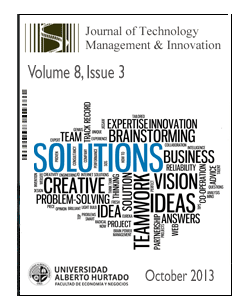Customer Integration in Service Innovation: An Exploratory Study
DOI:
https://doi.org/10.4067/S0718-27242013000400003Keywords:
customer integration, customer roles, open innovation, service innovation, service management.Abstract
Prominent industry projects, as well as an extensive literature suggest the importance of customer integration for companies’ innovation success. This appears to be especially true for service firms, which inherently build on customer interaction. Despite this appreciation of the approach, there are comparably few empirical analyses of the positive and negative effects of customer integration. In this exploratory study, we build on established customer role concepts to study the status quo of customer integration in industry, as well as reservations against the roles and negative experiences from customer integration projects. The study reveals a gap between reservations and actual negative experiences in losing know-how, as well as a positive effect of experience in customer integration on perceived benefits for the company.Downloads
References
AUH, S., Bell, S. J., McLeod, C. S., Shih, E. (2007). Co-production and customer loyalty in financial services. Journal of Retailing, 83(3), 359-370.
BETTENCOURT, L. A. (1997). Customer voluntary performance: Customers as partners in service delivery. Journal of Retailing, 73(3), 383-406.
BITNER, M. J., Booms, B. H., Mohr, L. A. (1994). Critical Service Encounters: The Employee's Viewpoint. Journal of Marketing, 58(4), 95-106.
BOYER, K. K., Hallowell, R., Roth, A. V. (2002). E-services: operating strategy – a case study and. Journal of Operations Management, 20(2), 175-188.
BÜTTGEN, M. (2009). Erscheinungsformen der Kundenintegration und Ansätze eines Integrationsmanagements. In: Stauss, B. (Ed.), Aktuelle Forschungsfragen im Dienstleistungsmarketing. Gabler, Wiesbaden. pp. 105-132.
CHERVONNAYA, O. (2003). Customer role and skill trajectories in services. International Journal of Service Industry Management, 14(3), 347-363.
CHESBROUGH, H. W. (2003). Open Innovation: The New Imperative for Creating and Profiting from Technology. Harvard Business School Press, Boston.
CORVELLO, V., Iazzolino, G. (2013). Factors Affecting the Practices of External Problem Solvers in Broadcast Search. Journal of Technology Management and Innovation. 8(2), 166-177.
DOHMEN, P., Kryvinska, N., Strauss, C. (2012). "S-D Logic" Business Model - Backward and Contemporary. In: Snene, M. (Ed.), Exploring Services Science. Springer, Berlin. pp. 140-154.
ENKEL, E., Kausch, C., Gassmann, O. (2005). Managing the Risk of Customer Integration. European Management Journal, 23(2), 203–213.
GOULD, R. W. (2012). Open Innovation and Stakeholder Engagement. Journal of Technology Management and Innovation. 7(3), 1-11.
GRAF, A., (2007). Changing roles of customers: consequences for HRM. International Journal of Service Industry Management, 18(5), 491-509.
HEIDEMANN, J., Kamprath, N., Müller, A.-L. (2011). Die Integration des Kunden in Geschäftsprozesse – ein ökonomisches Modell und dessen Anwendung am Beispiel eines Versicherungsunternehmens. In: Bernstein, A., Schwabe, G. (Eds.), Proceedings of the 10th International Conference on Wirtschaftsinformatik. Zürich. pp. 119-128.
HERSTATT, C., von Hippel, E. (1992). From experience: Developing new product concepts via the lead user method: A case study in a "low-tech" field. Journal of Product Innovation Management, 9(3), 213-221.
KURZMANN, H., Reinecke, S. (2009). Kundenintegration zwischen Kooperation und Delegation – Konzepte und Relevanz aus Managementsicht. In: Bruhn, M., Stauss, B. (Eds.), Kundenintegration: Forum Dienstleistungsmanagement. Gabler, Wiesbaden. pp. 193-212.
LENGNICK-HALL, C. A. (1996). Customer Contributions to Quality: A Different View of the Customer-Oriented Firm. The Academy of Management Review, 21(3), 791-824.
LOVELOCK, C. H., Young, R. F. (1979). Look to customers to increase productivity. Harvard Business Review, 57(3), 168-178.
MÖLLER, S., Fassnacht, M., Heider, R. (2009). Wenn der Kunde mehr ist als Käufer und Nutzer – Motive kollaborativer Wertschöpfungsprozesse. In: Bruhn, M., Stauss, B. (Eds.), Kundenintegration. Gabler, Wiesbaden. pp. 263-280.
OLSEN, T. O., Welo, T. (2011), Maximizing Product Innovation through Adaptive Application of User-Centered Methods for Defining Customer Value. Journal of Technology Management and Innovation, 6(4), 172-192.
PILLER, F. T., Möslein, K., Stotko, C. M. (2004). Does mass customization pay? An economic approach to evaluate customer integration. Production Planning and Control: The Management of Operations, 15(4), 435-444.
PRAHALAD, C. K., Ramaswamy, V., (2000). Co-opting Customer Competence. Harvard Business Review, 78(1), 79-86.
SAUNDERS, M., Lewis, P., Thornhill, A. (2009). Research methods for business students. 5th ed., Pearson Education Limited, Harlow.
SAWHNEY, M. (2002). Don't Just Relate – Collaborate. MIT Sloan Management Review, 43(3), 96.
SCHNEIDER, B., Bowen, D. E. (1995). Winning the Service Game. Harvard Business School Press, Boston.
SCHNEIDER, B., Ehrhart, M. G., Mayer, D. M., Saltz, J. L., Niles-Jolly, K. (2005). Understanding Organization-Customer Links in Service Settings. The Academy of Management Journal, 48(6), 1017-1032.
SRIVASTAVA, R. K., Tasadduq, A. S., Fahey, L. (1999). Marketing, Business Processes, and Shareholder Value: An Organizationally Embedded View of Marketing Activities and the Discipline of Marketing. Journal of Marketing, Volume 63, 168-179.
STAUSS, B. (2008). International Service Research – Status Quo, Developments, and Consequences for the Emerging Services Science. In: Stauss, B., Engelmann, K., Kremer, A., Luhn, A. (Eds.) Service Science. Springer, Berlin. pp. 57-70.
SWAN, J. E., Oliver, R. L. (1989). Postpurchase communications by consumers. Journal of Retailing, 65(4), 516-533.
TASHAKKORI, A., Teddlie, C. (1998). Mixed methodology: combining qualitative and quantitative approaches. Sage, London.
TEMEL, S., Mention, A-L., Torkkeli, M. (2013). The Impact of Cooperation on Firms’ Innovation Propensity in Emerging Economics. Journal of Technology Management and Innovation, 8(1), 54-64.
VARGO, S. L., Lusch, R. F. (2004). Evolving to a New Dominant Logic for Marketing. Journal of Marketing, 68(1), 1-17.
WIND, J., Rangaswamy, A. (2001). Customerization: the next revolution in mass customization. Journal of interactive Marketing, 15(1), 13-32.
XIE, C., Bagozzi, R., Troye, S. (2008). Trying to prosume: toward a theory of consumers as co-creator of value. Journal of the Academy of Marketing Science, 36(1), 109-122.
XUE, M., Harker, P. T. (2002). Customer Efficiency – Concept and Its Impact on E-Business Management. Journal of Service Research, 4(4), 253-267.
Downloads
Published
How to Cite
Issue
Section
License
Copyright (c) 2013 Journal of Technology Management & Innovation

This work is licensed under a Creative Commons Attribution-ShareAlike 4.0 International License.







